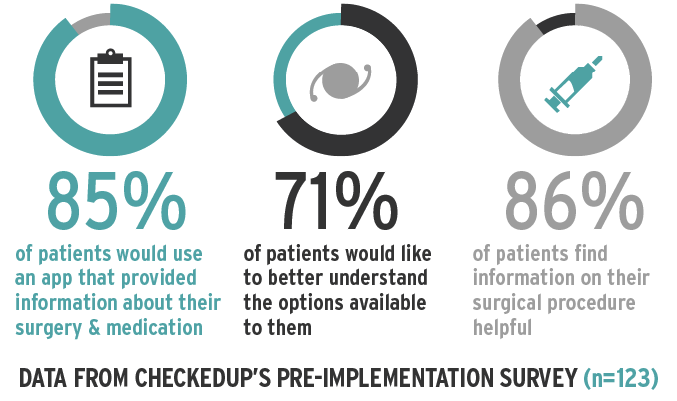What was the motivation behind the development of CheckedUp?
Currently, our health care system prevents doctors and patients from communicating effectively. CheckedUp was developed to bridge the gap between individuals and their health care providers and to allow patients to feel empowered throughout their care process.
As an Assistant Professor at the Bascom Palmer Eye Institute, I started noticing the inefficiencies in communication in my practice when patients were confused and uninformed about their conditions. They were, however, eager to take an active role in their care. I realized that a solution to this issue was to embrace mobile technology. Therefore, we created a platform that allows doctors to improve the quality and consistency of each patient interaction, both within and outside their practices.
Can you briefly describe how it works for patients? And for physicians?
CheckedUp’s mobile health care application has two different interfaces—one for patients and one for doctors. We work directly with our Medical Advisory Board to create medically accurate information on conditions and treatments. This content is then available to doctors, who choose which information each patient sees according to his or her personal medical history and condition.
This personalized content lets patients make informed decisions regarding their surgeries, medications, and treatment options, while simultaneously reducing their anxiety levels. The patient-facing interface assists patients in preparing for procedures, communicating preferences with their doctor, and sharing information with their families or caregivers. Patients can also receive medication and appointment reminders as well as coupons and vouchers from the convenience of their computer, tablet, or phone.
What are the benefits of a mobile technology platform?
The health care industry has grown to embrace the use and applications of digital and mobile technologies. Mobile health care solutions have been shown to improve patient satisfaction, decrease morbidity, and increase the ability of health care providers to monitor patients outside clinical or hospital settings.
Specifically, mobile technology allows for the increased frequency and quality of communication between doctors and patients, thereby strengthening the doctor-patient relationship and the overall quality of care. Furthermore, it gives patients immediate access to accurate medical information, empowering them and allowing them to feel in control of their care.
CheckedUp’s clinical trial surveyed more than 120 cataract patients in four of the nation’s highest-volume clinics. The results indicated that the majority of patients felt a great need for more information, more time with their doctor, and materials to engage with after their doctor’s appointment. We are designing CheckedUp to directly respond to these unmet needs voiced by patients. Our post-implementation clinical trial is analyzing our progress in these areas and how much the platform increases clinic efficiency.

Results indicated that the majority of patients surveyed desired a better understanding of and more information about their condition and treatment.
How do you anticipate CheckedUp affecting the doctor-patient relationship?
Our platform extends the doctor-patient relationship beyond office walls. CheckedUp empowers patients through educational content, customized for them and their procedure by their doctor, so that they can become advocates for their treatment preferences. It takes advantage of the high rates of mobile adoption among doctors and patients and aims to strengthen the relationship between them.
CheckedUp helps doctors overcome communication challenges (time, influx of patients, etc.) by ensuring that by the time patients get in the office chair, they are able to have a more meaningful conversation. The platform also allows patients to integrate their loved ones or caretakers into their treatment plans. With access to information and medical alerts from home, patients have a greater chance of medication adherence and, thus, better health outcomes.
How does CheckedUp fit into the landscape of a growing patient population, from the baby boomers to the Affordable Care Act?
Due to the influx of patients into clinics after the passage of the Affordable Care Act, there is a growing need for health solutions that make practices more efficient. CheckedUp allows doctors to provide high-quality, concierge medicine to each and every patient because it increases the efficiency of clinics by making patients’ chair time more productive. Educational modules answer patients’ basic questions about their condition or treatments, allowing for a deeper and more meaningful conversation in person.
CheckedUp is particularly well suited for the field of ophthalmology, in which such a large proportion of patients are elderly. The platform was designed with baby boomers in mind—the interface is easy to use, the FAQ section is always readily accessible, and the content is simply structured so that it is easily digested.
Can you tell us about some future goals and/or advancements?
Our immediate goal is to utilize the feedback we receive from our Explorers Program, the first clinics where our platform has been implemented, to enhance our platform’s functionalities to best serve the needs of high-volume clinics.
